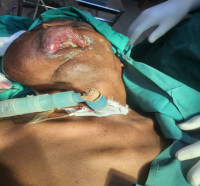Tracheostomy in Oral and Maxillofacial Surgery: indications and techniques.
Main Article Content
Abstract
Background: Tracheostomy as a common surgical procedure in maxillofacial surgery is indicated in difficult intubation, severe orofacial infections, neoplasms, traumatic respiratory obstruction and congenital orofacial malformations. Study reviewed the indications and techniques used for tracheostomy in maxillofacial surgical patients in a teaching hospital.
Method: This was a retrospective study of the clinical aspects, treatment methods, and clinical course of 54 patients who underwent tracheostomies by a consultant in the Dental/Maxillofacial Clinic of Barau Dikko Teaching Hospital, between January, 2010 and April, 2024. Data collected from the accident and emergency, theatre and outpatient clinic registers, included patient age, clinical diagnosis, indications for tracheostomy, surgical procedures performed and complications.
Result: 54 patients had tracheostomy as elective and emergency surgeries during the period. Male to female ratio was 1.25: 1.00. Commonest indications was ankylosis of the temporomandibular joints (n=16, 29.63%), then massive tumors of the mandible (n= 12, 22.22%); panfacial fractures was the least (n=2, 3.70%). Elective surgeries (n=45, 83.33%) were the commonest interventions. Unilateral and bilateral condylectomies were the commonest procedures done (n=12, 22.22%). Intraoperative complications include bleeding and paratracheal placement of tube. Postoperative complications include blockage of tube with secretions and blood clot; subcutaneous surgical emphysema was significant in few patients after closure of the tracheostomy site. No patient had tracheal stenosis and the wound healed satisfactorily.
Conclusion: The standardized surgical technique presented here reduces the associated surgical risk. Maxillofacial surgeons need to be proficient in tracheostomy. Good knowledge of anatomy of important structures and handling them correctly greatly reduces complications.
Downloads
Article Details
Section

This work is licensed under a Creative Commons Attribution-NonCommercial-ShareAlike 4.0 International License.
The Journal is owned, published and copyrighted by the Nigerian Medical Association, River state Branch. The copyright of papers published are vested in the journal and the publisher. In line with our open access policy and the Creative Commons Attribution License policy authors are allowed to share their work with an acknowledgement of the work's authorship and initial publication in this journal.
This is an open access journal which means that all content is freely available without charge to the user or his/her institution. Users are allowed to read, download, copy, distribute, print, search, or link to the full texts of the articles in this journal without asking prior permission from the publisher or the author.
The use of general descriptive names, trade names, trademarks, and so forth in this publication, even if not specifically identified, does not imply that these names are not protected by the relevant laws and regulations. While the advice and information in this journal are believed to be true and accurate on the date of its going to press, neither the authors, the editors, nor the publisher can accept any legal responsibility for any errors or omissions that may be made. The publisher makes no warranty, express or implied, with respect to the material contained herein.
TNHJ also supports open access archiving of articles published in the journal after three months of publication. Authors are permitted and encouraged to post their work online (e.g, in institutional repositories or on their website) within the stated period, as it can lead to productive exchanges, as well as earlier and greater citation of published work (See The Effect of Open Access). All requests for permission for open access archiving outside this period should be sent to the editor via email to editor@tnhjph.com.
How to Cite
References
Gysin C, Dulguerov P, Guyot JP, Perneger TV. Abajo B, Chevrolet JC.
Percutaneous versus surgical tracheostomy. Ann Surg. 1999; 230 (5): 78-79.
Crosher R, Baldie C, Mitchell R. Selective use of trachestomy in surgery for head and neck cancer: An audit. Br J oral Maxillofac Surg. 1997; 35:43-45.
Casting B, Telfar M, Avery BS. Complication of tracheostomy in major head and neck cancer surgery: A retrospective study of 60 consecutive cases. Br J oral Maxillofac Surg. 1994:32:3-5.
Halfpenny W, McGurck M. Analysis of Tracheostomy-associated morbidity after operations for head and neck cancer. Br J Oral Maxillofac Surg. 2000; 38:509-12.
Barak M, Bahouth H, Leiser Y, El-Naaj I. Airway management of the patient with maxillofacial trauma: Review of the literature and suggested clinical approach. Biomed Res Int 2015; doi: 10.1155/2015/724032.
MittalG, Mittal RK, Katyal S, Uppal S, Mittal V. Airway management in maxillofacial trauma: do we really need tracheostomy? Submental intubation. J Can Clin Diag Res 2014; 8(3): 77-79.
Anehosur VS, Karadiguddi P, Joshi VK, Lakkundi BC, Ghosh R et al. Elective tracheostomy in head and surgery; our experience. J Clin Diagn Res 2017; 11(5): ZC36-ZC39.
Waldron J, Padgham ND, Hurley SE. Complications of emergency and elective tracheostomy: A retrospective study of 150 consecutive cases. Ann R Coll Surg Engl. 1990;72: 218-220.
Aicher S, Givol N, Peleg M, Ardekian L. Changing Indications for tracheostomy in Maxillofacial trauma. J Oral Maxillafac Surg. 1996; 54: 292-96.
Scutz P, Hamed H. Submental Intubation versus tracheostomy in maxillofacial trauma patients. J Oral Maxillofac Surg. 2008; 66:1404-09.
Ong SK, Morton RP, Kolbe J, Whitlock RM, Mclvor NP, Pulmonary complications following major head and neck surgery with tracheostomy: A prospective randomized, controlled trial of prophylactic antibiotics. Arch Otolaryngol Head Neck Surg. 2004; 130:1084-87.
Phero JC, Rosenberg MB, Giovannitti JA. Adult airway evaluation in oral surgery. Oral Maxillofac Surg Clin North Am. 2013; 25: 385-899.
Kenan PD. Complications associated with tracheostomy: prevention and treatment. Otolaryngol Clin North Am. 1979; 12: 807 -816

